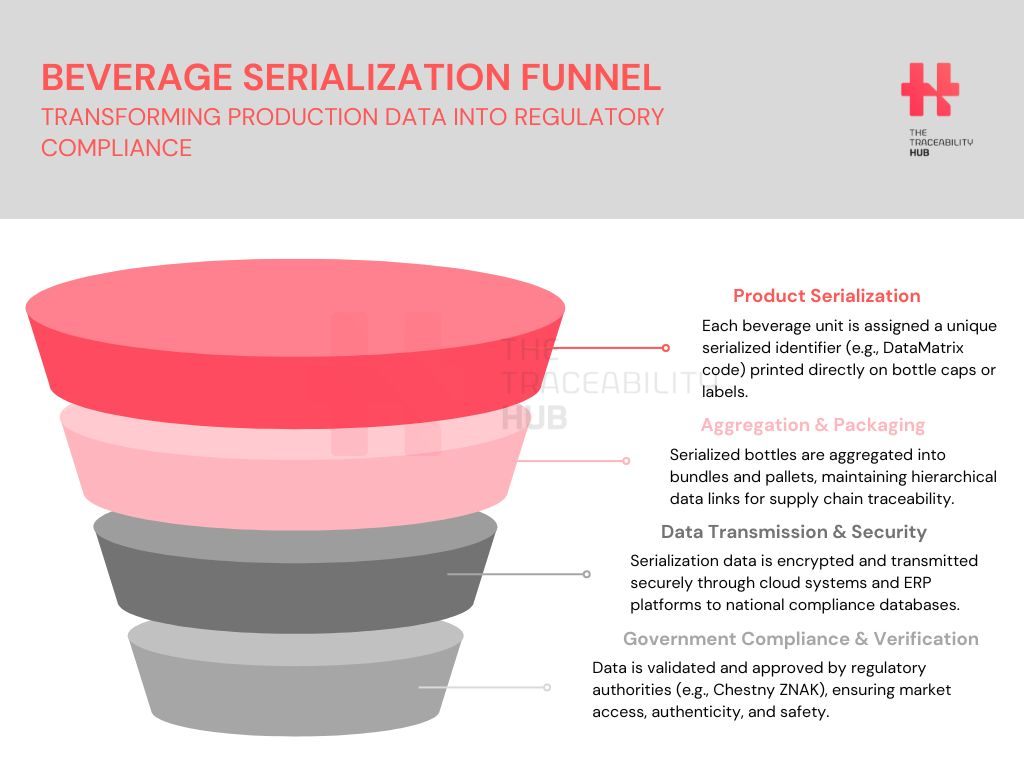Beverage Industry Compliance: Beer and Water
In today’s highly regulated beverage industry, serialization and compliance are essential for ensuring product authenticity, beverage supply chain transparency, and consumer safety. Governments worldwide are mandating stricter traceability regulations to combat counterfeiting, bolster quality control, and facilitate product recalls when necessary.
For beer and bottled water manufacturers, beverage compliance is particularly complex due to the high volume of production and distribution, the necessity of batch tracking, and increasing concerns over illicit trade and counterfeit goods.
Brands must navigate a regulatory landscape that varies by country, adapting to diverse legal standards and technical requirements.
Regulatory Landscape: Beer & Water Serialization Requirements
Key Global & Regional Beverage Regulations
- Russia’s Chestny ZNAK: One of the most stringent traceability systems worldwide, requiring unique DataMatrix codes on every bottle or package.
These codes include cryptographic authentication and must be reported to a centralized government platform to prevent counterfeiting and unauthorized trade. - European Union beverage industry compliance: While full serialization is not yet mandatory for beer and water, the upcoming digital product passport (DPP) initiatives may push brands toward enhanced product transparency and recyclability tracking.
- Emerging beverage industry regulations in Asia, the U.S., and Latin America: China has introduced track-and-trace systems for alcoholic beverages, while Latin American countries such as Brazil and Mexico are adopting serialization for food and beverages to improve tax compliance and beverage supply chain visibility.
In the U.S., similar requirements may arise as the FDA beer regulations continues to expand food safety and traceability rules.
Compliance Challenges for Beverage Brands
- Adapting to diverse legal and technical mandates: Multinational brands must ensure beverage compliance across different serialization frameworks, labelling formats, and government reporting structures.
- Managing international beverage supply chains: Production, packaging, and distribution often occur across multiple countries, requiring an integrated approach to ensure consistent food safety traceability across all supply chain nodes.
- Data accuracy and government reporting: Serialization requires real-time data capture and transmission to regulatory platforms.
Any discrepancies can lead to severe penalties, product recalls, or restricted market access.
Key Challenges in Implementing Serialization for Beer & Water
Compliance with Local Beverage Regulations
- Navigating complex technical and legal requirements, including Chestny ZNAK mandates in Russia.
- Ensuring seamless reporting to government traceability platforms.
Technological Integration
- Implementing serialization and aggregation solutions that work within existing production and logistics frameworks.
- Adapting to different beverage packaging formats (bottles, bundles, pallets) and printing surfaces (caps, labels, packaging).
Beverage Serialization Funnel

Safety in Drinks: Data Management & Security
Ensuring an effective serialization system for beer and water requires an advanced approach to data management and security. Companies must handle vast amounts of data generated at different stages of production, packaging, and distribution.
The following aspects are critical:
- Real-time data capture and secure transmission: Serialization mandates require the generation, scanning, and reporting of unique product identifiers at various supply chain checkpoints. Any lag or misalignment in data transfer can lead to regulatory violations. Secure beverage transmission protocols, including encryption and blockchain-based logging, help protect data integrity.
- Compliance with government data hubs: In Russia, Chestny ZNAK demands that every serialized product be reported through a government-verified platform. Any error in data transmission, such as incorrect product codes, duplicate serials, or missing aggregation links can result in hefty fines or product rejection at customs checkpoints.
- Avoiding beverage compliance failures: Missing or inaccurate serialization data can lead to compliance failures, disrupting the supply chain and causing reputational damage. Automated error-checking mechanisms, machine learning algorithms for anomaly detection, and cloud-based audit trails can help ensure data accuracy and compliance.
- Risk assessment/detection and alerts
- Legal interpretation and lawsuits
- Cybersecurity threats: As serialization systems rely heavily on cloud computing and interconnected enterprise resource planning (ERP) platforms, the risk of cyberattacks increases. Implementing strong cybersecurity measures such as multi-factor authentication, role-based access controls, and secure API integrations is essential to safeguard sensitive serialization data from unauthorized access or tampering.
Customer Request: Implementing a Fully Compliant Beverage Traceability System
Beverage Traceability: Objective
Develop a serialization solution (for example like the one aligned with Russian beer and water regulations), ensuring traceability across the entire supply chain.
Beverage Traceability: Requirements
- Implement DM (Data Matrix) code printing on bottle caps.
- Enable aggregation from bottle to bundle to a pallet for logistical efficiency.
- Establish a seamless reporting system to transmit serialized data to regulatory platforms.
- Provide training and technical support for production teams.
Proposed Solution: Serialization & Aggregation System
Line System: Serialization & Aggregation Implementation
DM Code Printing on Bottle Caps
- Direct inline printing with pre-treatment to meet code grading requirements.
- Each serialized code contains a unique serial number and product-specific data.
Beverage Aggregation Process
- Hierarchical tracking of bottle serials with bundle/pallet aggregation for logistics.
- Ensuring proper data correlation and hierarchy management across the beverage supply chain.
End-to-End Data Flow & Government Compliance
- Serialization hierarchy is transmitted through different software layers to regulatory hubs.
Beverage Software Solution: Data Management & Compliance Reporting
Cloud-Based Serialization Management
- Serial number generation and GTIN assignment.
- Secure encryption and crypto code authentication with Russian government authorities.
Seamless Data Exchange with Regulatory Systems
- Data transfer between production, enterprise software, and government traceability platforms.
- Automated reporting of activated serial numbers, ensuring compliance.
Key Benefits for Beverage Brands
Beverage Regulatory Compliance
- Full adherence to serialization laws, preventing fines and beverage market restrictions.
Anti-counterfeit Beverage Solutions & Brand Protection
- Unique serial numbers ensure authenticity and safeguard against counterfeit beverages.
Beverage Supply Chain Efficiency
- Aggregation processes streamline inventory management and logistics.
Data Accuracy & Risk Mitigation
- Secure, real-time data transfer minimizes regulatory risks and errors.
Serialization Regulations of Beverage Supply Chains: Next Steps
Adapting to serialization regulations in some Countries is no longer optional, it’s compulsory, and in other cases it is a competitive necessity for beverage brands. To thrive in regulated markets, companies must embrace digital traceability, automation, and compliance-driven serialization. Investing in a scalable drink serialization system not only ensures regulatory adherence but also protects brand reputation and enhances operational efficiency.
For a deeper dive into evolving regulations, check out our next article.
Read more: EU Wine Labelling Overhaul: Nutritional Transparency & Sustainability Rules Explained.






